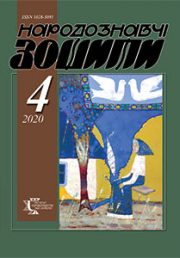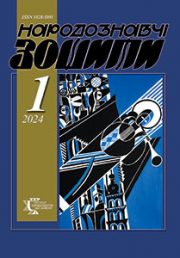The Ethnology Notebooks. 2019, № 3 (147), 705—714
UDK 39:624.011.1:691:391.985](477.83/.87)
DOI https://doi.org/10.15407/nz2019.03.705
FAYNYK Tetyana
ORCID ID: https://orcid.org/0000-0001-8446-4002
Doctor of Sciences in History, Senior Researcher
in the Institute of Ethnology, Ethnology of Modernity
Department: National Academy
of Sciences Ukraine,
15, Svobody Avenue, 79000, Lviv, Ukraine
Contacts: е-mail: t.faynyk@gmail.com
Abstract. This article is written on the basis of literary sources and materials of field research within the Carpathian region. Traditional folk outlook approaches, the selection of natural materials for housing construction are highlighted in this article. The attention accents to the deeply spiritual attitude of the Ukrainian highlanders to the environment, which should be developed by our contemporaries. The object of the research is the popular wooden housing construction, and the subject — the properties of wood, people’s beliefs and beliefs about it. We used in our study the historical-comparative method and methods of field ethnography: interviews, observations and photophixation. The basis of our work is the field materials of the author, collected on the territory of Lviv and Ivano-Frankivsk, Zakarpattia and Chernivtsi regions of Ukraine. On the basis of the collected materials and beliefs about wood materials collected during the expeditions that are still preserved in the memory of the Ukrainian people, the author aims to show the deep spiritual attitude of Ukrainians to the surrounding nature and the importance of traditions in the selection of material for housing construction. The urgency of the proposed topic is that, when preparing materials for construction, taking care of proper equipment for their homes and the yard, providing themselves with wealth and well-being, people thoughts about spiritual world and preservation of nature. Our goal in the proposed article is to show that popular ideological ideas and beliefs served not only ideology, but also a kind of methodology in the construction business. Myths, legends, folk signs, rituals gave the folk knowledge about the properties of wood, its suitability for construction. Traditions of wooden housing construction of the second half of the nineteenth and early twentieth centuries in the Ukrainian Carpathians reflect the all-Ukrainian ideological approaches, which are based on the following-reproduction of an archetype model of the world coming from mythology. Confirmation of this is the whole system of prohibitions and encouragements, recommendations, beliefs, signs, magic acts in the world of wildlife. In addition to the experience gained from the real communication of the inhabitants of the Carpathians with the natural surroundings, the traditions reflecting the ideological views of the people were of great importance in the selection of material for housing. They combine pre-Christian beliefs about the universe of mythological origins with the Christian, derived from the biblical plots. They form the spiritual basis of building traditions, which also enrich the spiritual culture of the people.
Keywords: world perception, world outlook, natural environment, tree, wood, beliefs, building material, traditions.
Received 24.04.2019
REFERENSES
Vincens, S. (1997). On a high polonyna. Lviv: Chervona Kalyna [in Ukrainian].
Hilarion Metropolitan. (1992). Pre-Christian beliefs of the Ukrainian people. Historical and religious monograph. Кyiv [in Ukrainian].
Kirchiv, R.F. (1987). Worldview concepts and beliefs. Hutsulshchyna Historical and ethnographic research (Pp. 243—260). Кyiv: Naykova dymka [in Ukrainian].
Ryabchuk, V.P. (Ed.). (2004). The forest is green — heart is merry. Proverbs and sayings. Lviv: Kamula [in Ukrainian].
Koberska, T. (2005). Boundary existences in the Ukrainian mythological and religious outlook. History of Religions in Ukraine. Scientific Yearbook (Book І, pp. 60—65). Lviv: Logos [in Ukrainian].
Bagniuk, A. (2010). Symbols of Ukrainians. Artistic and information guide. Ternopil: Educational Book; Bogdan [in Ukrainian].
Gogol, N.V. (1960). Evenings on a Farm Near Dikanka. The collection of works of art in five volumes (Vol. I). Moskva [in Russian].
Lozko, G. (1994). Ukrainian paganism. Кyiv [in Ukrainian].
Moszyсski, K. (1929). Folk culture of the Slavs. Warsaw [in Polish].
Ukrainian people in their legends, religious beliefs and beliefs (1992). Кyiv: Dovira [in Ukrainian].
Kostomarov, M.I. (1994). Slavic mythology. Slavic mythology. Selected works on folklore and literary criticism (Pp. 201—256). Кiev: Lybid [in Russian].
Golovatsky, Ya.F. (1991). Presentations of ancient Slavic legends or mythology (P. 49). Kyiv [in Ukrainian].
Agapkina, T.A. (1999). Oak. In Tolstoy, N.I. (Ed.). Slavic antiquities. Ethnolinguistic dictionary (Vol. 2 D—K (Crumb), pp. 141—146). Moscow: International Relations [in Russian].
Veletskaya, N.N. (1978). The pagan symbolism of the Slavic archaic rituals. Moskva [in Russian].
Propp, V.Ya. (1986). The historical roots of the fairy tale. L. [in Russian].
Fischer, A. (1933). Trees in the beliefs and rites of the Polish people. A copy from the ethnographic quarterly (Vol. 35). Lviv: Lud [in Polish].
Usachova, V.V. (1999). Maple. In Tolstoy, N.I. (Ed.). Slavic antiquities. Ethnolinguistic dictionary (Vol. 2 DK (Crumb), pp. 507—509). Moscow: International Relations [in Russian].
Agapkina, T.A. (2012). Poplar. In Tolstoy, N.I. (Ed.). Slavic antiquities. Ethnolinguistic dictionary (Vol. 5, pp. 282—284 (Tale — Lizard). Moscow: International Relations [in Russian].
Faynyk, T.M. (2007). Housing and environment: building traditions of Ukrainian Carpathians. Lviv [in Ukrainian].
Onyshkevich, M.Ya. (1984). Dictionary of Boiko dialects. In two volumes. Kyiv: Naykova dymka (Part I, II) [in Ukrainian].
Goshko, Yu.G. (1976). The population of the Ukrainian Carpathians of the XV—XVIII centuries: Population. Migrations Everyday life. (Academy of Sciences of the USSR — State Museum of Ethnography and Arts). Kyiv: Naykova dymka [in Ukrainian].
Nechui-Levytsky, I. (1992). Worldview of the Ukrainian people. Sketch of Ukrainian mythology. Kyiv: Oberig [in Ukrainian].
Czajkowski, J. (1969). Rural housing in the Beskid Niski and adjacent Pogуrze. Vintage Museum of the Rzeszуw Province (Vol. II). Rzeszуw [in Polish].
Faynyk, T.M. (1996). Traditional-national construction technology in the Ukrainian Carpathians. Scientific and Methodical Bulletin, 1, 9—17; Lviv Scientific and Practical Center of the Institute of Pedagogy and Psychology of Professional Studies of the Academy of Pedagogical Sciences of Ukraine. Lviv [in Ukrainian].
Reinfuss, R. (1948—1949). Јemkowie as an ethnographic group. Ethnographic works and materials (Vol. VII). Lublin [in Polish].
Reinfuss, R. (1935). Folk architecture in the West Lemkivshchyna (Vol. XXXIII, pp. 83—112). Warsaw: Lud [in Polish].
Sopoliga, M. (1983). National Housing of Ukrainians of Eastern Slovakia. Bratislava; Presov [in Ukrainian].







